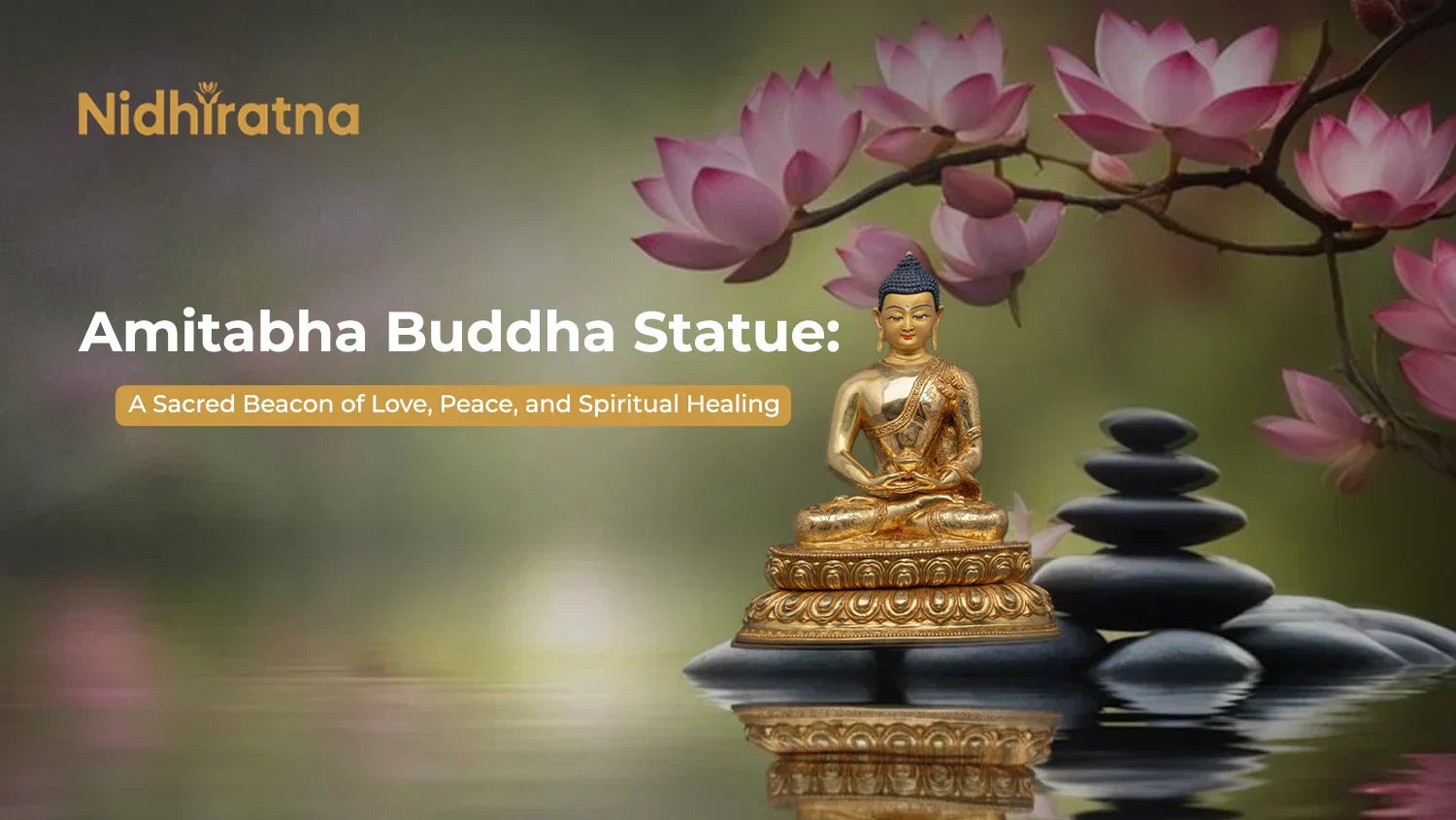The Amitabha Buddha Statue: A beacon of love, peace, and spiritual Healing
There are a few figures in Buddhist wisdom whose radiance can rival that of Amitabha, the Buddha of Infinite Light and Infinite Life. Amitabha is the embodiment of such compassion and illumination as neither of which has an end, to release all sentient beings from suffering. Through the above-defined virtues, he finds reverence in the Mahayana and Vajrayana traditions.
Whether you are a spiritual practitioner, lover of collecting objects, or deeply engrossed in art collectibles, understanding the meaning behind Amitabha Buddha opens the way for a much deeper connection with your inner self.
Who is Amitabha Buddha?
Amitabha Buddha-in Japanese Amida or by Opame in Tibetan, is the heavenly Buddha who is presiding over the western Pure Land called Sukhavati. The translation of his name is Infinite Light (Amitābha) and Infinite Life (Amitāyus), which indicates enlightenment and eternal compassion.
In the context of the Mahayana tradition, the 48 vows of Amitabha involved his promise to lead all beings towards liberation, facilitating rebirth in his 'Pure Land' of bliss, through sincere faith and devotion.
The statue of the Amitabha Buddha, therefore, represents the universality of compassion, calm, and infinite wisdom, making it a sacred figure in prayer rooms across the world, including households.
Symbolism and Iconography of the Amitabha Buddha Statue
Key Features with Their Meaning
Amitabha's statue has symbolic features that articulate Buddhist teachings in abundance:
-
Red Lotus: This flower represents purity from suffering and illustrates the transformation process through which spiritual suffering occurs.
-
Ushnisha: A cranial protuberance representing wisdom being matured.
-
Long Earlobes: Portraying silence importance of worldly attachments
-
Mudras (hand gestures): Amitabha is mostly represented in the Dhyana Mudra (meditation)
where the hands are calmly resting on the lap, meaning that he is at peace and contemplative, holding a begging bowl signifying charity and spiritual sustenance at times.
Symbol of Infinite Light
The Symbol of Infinite Light is intrinsic to the character of Amitabha. It is said that his radiance surpasses all other buddhas and illuminates the spiritual darkness that comes from ignorance and suffering.
Represents Infinite Light and Compassion:
The light of the Amitabha is more than just the visual quality of illumination, as his radiance represents the illumination of consciousness itself. The radiance of the Amitabha eradicates the darkness of illusion and fear, leading all the way to enlightenment. Like the sunshine, the compassion of the Amitabha is extended to all sentient beings without discrimination.
Beacon of Hope and Healing
Devotees believe that meditating on the statue of Amitabha, or chanting its mantra, "Namo Amituofo," or "Namo Amitābhāya," will bring inner peace will follow in their hearts and thus heal their power. His light purifies karmas, heals emotional wounds from the past, brings peace, and enables one to find one's way to forgiveness or self-forgiveness.
In this inner spiritual light, Amitabha shines as a beacon worth being pursued for spiritual rejuvenation; such is his gift of eternal love and the immense potential residing in every being.
Spiritual Healing: The Journey Towards Enlightenment
Associated with compassion and mindfulness
The story of Amitabha Buddha is that he represents infinite compassion (karuṇā) and mindful knowledge (smṛti). His teachings encourage practitioners to cultivate a heart of loving-kindness toward themselves and others.
The statue usually shows the figure of Amitabha engaged in deep meditation, symbolizing the state of full awareness of the current moment. The image serves as a reminder that the moment of enlightenment is already inside one's calm mind.
Path to Enlightenment
The purity of Pure Land Buddhism makes the way to the paradise of Amitabha through faith, recitation, and awareness, not through many rigorous ascetic practices. The Pure Land is a tranquil environment of Buddhahood without the distracting concerns from worldly affairs.
The statue of Amitabha Buddha is, therefore, the spiritual bridge connecting the earthly world and the spiritual world, announcing to his devotees that it is possible to obtain enlightenment without looking back on anything, whether one is born in the slums or palaces.
Serene Expression and Meaningful Hand Gesture
The serene expression on Amitabha symbolizes profound compassion and inner peace, coupled with hand gestures (mudras) having particular significance, which are:
-
Dhyana Mudra (Meditation Gesture): The hands rest on the lap, a symbol of mental concentration and spiritual balance.
-
Abhaya Mudra (Gesture of Fearlessness): upraised right hand, palm facing forward, assuring security and tranquillity.
Every component of his statue design carries a very deep meaning and guides devotees on the way to self-awareness and liberation.
The Essence of Amitabha's Presence
Symbolizing Peace and Compassion
It is believed that Amitabha's presence emits "radiant peace," an energy that renders the restive mind still and promises to restore harmony. The figure of the Amitabha Buddha embodies just that, standing out as a meditation, prayer, or healing focus.
His idol, amidst lotus petals, is often found, flanked by bodhisattvas Avalokiteshvara (Guanyin) and Mahasthamaprapta, who represent, respectively, compassion and wisdom. Together, they form the Amitabha Trinity, the trio showing balance between intellect and feeling and the spiritual practice.
Reminder of the inner Tranquillity within Sacred Places
An Amitabha statue is made to turn one's home, garden, or meditation room into a sanctuary of peace. Thus, the statue serves as a constant reminder to practice calmness, patience, and empathy every day.
According to Buddhist philosophy, the serenity outside is a reflection of the stillness, and connecting with Amitabha's energy can greatly help in achieving this harmony.
How to Meditate by Using Amitabha Buddha's Statues
Meditating with the Amitabha Buddha statue constitutes a meditation deepening mindfulness and devotion practice. Here is how to do the meditation process:
1. Creating the Calm Space:
Prepare the area in front of the statue, which faces West, that direction denoting the land of Pureland of Amitabha in the East.
2. Light a Candle or an Incense stick:
It represents offering light and scents to the Buddha, a sign of clarity and purity of intention.
3. Focus Your Gaze on the Eyes or Heart of the Statue:
Allow your eyes to rest on the calm expression of Amitabha. Feel his compassion radiating toward you.
4. Chant the Mantra:
Chant "Namo Amituofo" or "Namo Amitabha Buddha" softly. This activates the vibration of infinite love and healing.
5. Visualize the Light:
Imagine a soft golden light spreading from the statue into your heart and from your heart to all beings.
The mindful connection, transformed, thus sacred act of meditating into a profound and holy union by the self with the infinite.
Meaning of the Hand Gestures of Amitabha Buddha or Mudras

The significance of each gesture in the image of Amitabha conveys on all profound levels of teaching:
1. Dhyana Mudras(Meditation)
Both hands will rest in the lap, palms upwards, index fingers raised, touching each other, and thumbs touching lightly. Thus, it actually shows balance, unity, and concentration-all of which are essential for achieving enlightenment.
2. Abhaya Mudra (Fearlessness)
The raising of the right hand gives comfort to practitioners in that it conveys the meaning, "Do not fear, all beings are protected." The grace of presenting authority and spiritual security.
3. Varada Mudra (Compassion Giving)
Sometimes Amitabha's left hand gives a blessing downwards, palm-out, as it designates generosity and dispensed blessings.
This collective set of views comprises the interpretation of Amitabha as trying to be a guide to sentient beings-from fear to freedom.
Conclusion: The Living Light of Amitabha
The statue of the Amitabha Buddha transcends the role of religious icon; it is, in fact, the eternal embodiment of the light that dwells in every one of us. It invites us closer to the realization of love without borders, and of the peace beyond the turmoil of the world, in its gentle glow.
In meditation on Amitabha, or even gazing for a moment into the well of his compassionate eyes, one finds the silent lesson that enlightenment is never a goal but rather a way of being-a being illuminated by mindfulness and love.
For those who want to introduce into their lives the miraculous, serene presence of Amitabha Buddha, Nidhiratna is the place to go. This is a reputable e-commerce platform, which specialises in authentic, crafted statues of the Buddha from Nepal or other parts of the world, each carrying the artistry, blessing, and devotion that sustains life in modern homes.
Frequently Asked Questions (FAQs)
1. What are the primary characteristics of Amitabha Buddha?
The qualities of Amitabha are infinite light, infinite life, and infinite compassion. His most typical attributes are serenity, generosity, and the pledge to save all beings through his Pure Land.
2. What is Amitabha different from Shakyamuni Buddha?
Amitabha is a celestial body creating the Pure Land for others to attain enlightenment after their death, while Shakyamuni Buddha (Siddhartha Gautama) is the historical Buddha who attained enlightenment on Earth.
3. Can anyone keep the Amitabha Buddha statue at home?
Yes. Anyone with sincere respect and good intentions may keep an Amitabha statue. It is often placed in meditation rooms, altars, or west-facing directions to align with his Pure Land energy.
4. What are the meanings of the hand gestures of Amitabha Buddha?
His mudras are those of meditation, protection, and compassion, and thus, remind the practitioner to be in balance of wisdom and love in spiritual growth.


















Share:
Green Tara Statues: History, Meaning and Spiritual Significance
Jowo Rinpoche Buddha: The Sacred Heart of Tibetan Buddhism in Lhasa